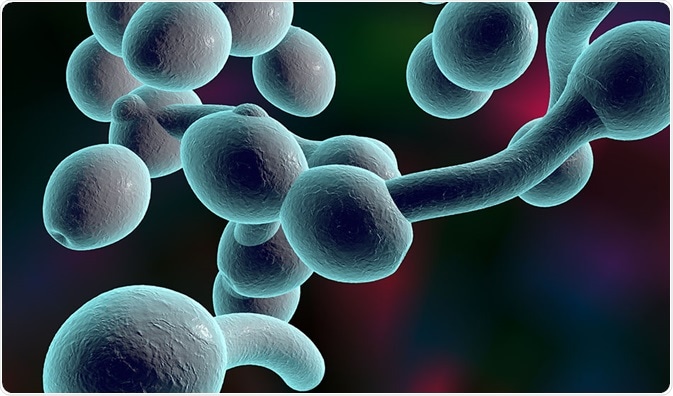The yeast two-hybrid (Y2H) system is a genetic technique used to determine protein–protein interactions. The approach is speedy, cost-effective, and easy to use.

Credit: Kateryna Kon/Shutterstock
Interaction mapping gives clear explanations about the organization of the proteome (organisms, tissues, and cells express the full complement of proteins) into functional units. This data is critical for the elucidation of biological mechanisms.
Y2H tools serve as access to the entire cellular proteome for screening protein–protein interaction, including membrane proteins, proteins localized in different subcellular compartments, and proteins that are transcriptionally active.
Y2H can be automated for high throughput researches of protein–protein interaction on a genome-wide scale.
Principle of the Y2H system
Protein–protein interaction that takes place between bait and prey proteins aids in activation of reporter genes that allow growth on a color reaction or specific media.
The term “two-hybrid” is coined from the two classes of hybrid or chimeric proteins. Protein of interest "x" and a DNA binding domain (DBD-x) fuse to form “bait.” Fusion of transcriptional activation domain (AD-y) and a cDNA library "y" results in “prey.” These two classes form the basis of the protein–protein interaction detection system.
Without bait–prey interaction, the activation domain cannot restrict to the reporter gene-to-gene expression drive.
Variations of Y2H
The variations in the Y2H system depend on the interaction of proteins. Current available systems are:
Repressed transactivator system
The repressed transactivator (RTA) Y2H system was created to identify interactions that involve transcriptional activator proteins genetically.
Modifications in this system enable it to be used for monitoring inhibitors of protein–protein interactions that involve libraries of small molecule compounds.
Inhibition of interactions that involve proteins can be evaluated by screening growth in selective medium that contains 3-aminotriazole (3-AT).
This method has also been utilized to identify inhibitions of four independent protein–protein interactions in screens that contained a 23,000 small molecule compound library. The compounds that inhibited one of the FKBP12–TGFbeta-R (transforming growth factor beta) was also inhibited.
Polymerase III transcription system
The Polymerase III (Pol III) transcription system allows interaction of transcription factors with proteins by activating transcription that is based on RNA polymerase II. The protein X is fused to bait (Gal4-DBD) in the traditional Y2H system. Initiation of the binding sequence of Gal4p into SNR6 (reporter gene) results in the ability of bait to attach DNA.
Nevertheless, the prey construct is altered as the second protein Y gets fused to τ138p.TFIIC complex contains this protein as a subunit.
τ138p exists as one of the two transcription factors that undergoes (RNA polymerase III) Pol III-mediated transcription. The interaction that occurs between the bait and the prey (containing τ138p) results in binding of the TFIIIC complex to DNA and recruitment of TFIIIB (a second transcription factor) and Pol III.
This results in activation of the SNR6 reporter gene transcription to develop U6 snRNA.
Screening for interactions between extracellular proteins system
Screening for interactions between extracellular proteins system (SCINEX-P system) permits the analysis of protein interactions that take place in the oxidizing environment of endoplasmic reticulum.
In this system, fusion takes place between the mutated Ire1p proteins and the proteins of interest, where mutated Ire1p proteins lack their luminal domain.
The interaction that occurs between the two hybrid proteins results in reconstitution of Ire1p dimerization and activation of unfolded protein response (UPR) downstream signaling. The Hac1p unfolded protein response element that has been introduced into the reporter gene promoter helps in screening protein–protein interaction.
This Y2H system has been successfully implemented for analysis of interaction between Calnexin and protein disulfide isomerase ERp57, and interactions between antibodies and antigens.
The SOS- and the RAS recruitment systems (SRS and RRS)
The SOS recruitment system involves the fusion of a soluble protein X into the mammalian SOS. Interaction between SOS-X fusion and a prey that is localized in a membrane results in promotion of downstream signaling and stimulation of guanyl exchange on yRAS.
The RAS recruitment system involves fusion of active mammalian RAS and the soluble protein X. The system requires only the membrane location and does not involve the Ras guanyl exchange factors’ activity.
Both RRS and SRS help in analyzing interactions that occur between membrane or soluble preys and soluble baits. The reverse RAS recruitment system has been particularly developed for utilization of baits that are membrane localized.
The G-protein fusion system
This system permits interaction between bait and soluble prey, which involves the fusion protein with gamma subunit of the heterotrimeric G-protein.
Interaction of prey with bait that is located on the membrane results in sequestration of G-protein β-subunits results in disruption of the heterotrimeric G-protein complex formation and successive downstream signaling.
This approach is most commonly used in identification of neuronal Sec1 mutants that are incapable of binding syntaxin1 (a SNARE complex member).
In addition to RTA Y2H, the G-protein Y2H identifies drugs that disrupt protein–protein interactions.
Further Reading